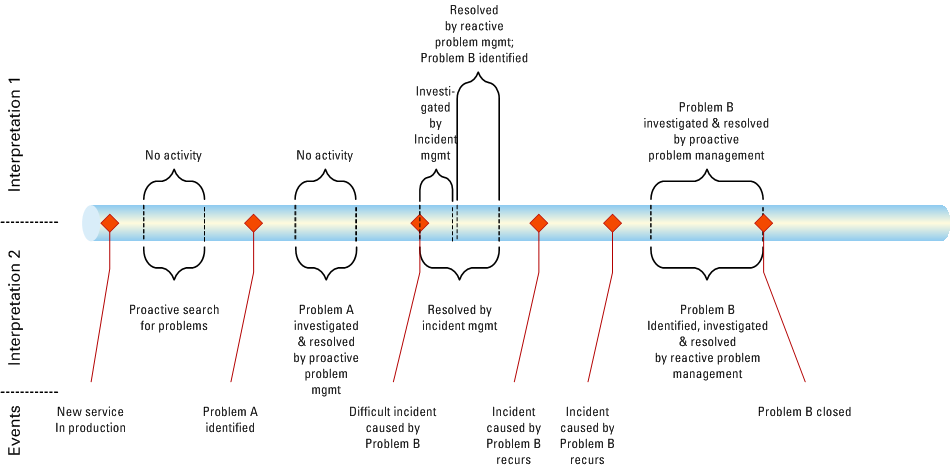Some organizations consider proactive problem management to be the work of resolving problems when they are not currently causing any incidents. This understanding is in direct conflict with an alternative interpretation, wherein proactive problem management concerns the identification and resolution of problems before they have caused any incidents at all.What is truly puzzling about the first understanding of the term “proactive” is that it leaves little room for “reactive” problem management. Sorting this out is useful, because it can help avoid tons of miscommunication. The simplest way of explaining the differences is in the following table:
| Activity | Interpretation 1 | Interpretation 2 |
|---|---|---|
| Resolving easy incidents | Incident management | Incident management |
| Resolving complicated, major or hard to resolve incidents | “Reactive” problem management | Incident management |
| Identifying recurring incidents | Proactive problem management | Reactive problem management |
| Analyzing and resolving problems that have related incidents, but none that are currently open | Proactive problem management | Reactive problem management |
| Identifying weaknesses and other risks in production that are likely to cause incidents if unresolved, but have not yet done so | ? (this probably never gets done) | Proactive problem management |
Here is a timeline showing a series of events and how they are handled according to interpretation 1 and interpretation 2:

My own view of these interpretations is heavily in favor of interpretation 2. I believe that interpretation 1 is just a bunch of rhetoric used by people who are trying to put a better face on their work than it truly merits. It is based on a poor process architecture, where two different processes—incident management and problem management—are used for a single purpose—resolving incidents. This is very bad design. Because interpretation 1 thinks of resolving incidents as being reactive, it therefore considers preventing future incidents—even though in reaction to past incidents—is “proactive”. Interpretation 2 has none of this confusion, is much purer, simpler and easier to manage. I think it is a much more professional understanding.
 The diagrams in this posting are licensed to you under the terms of the Creative Commons Attribution-NonCommercial-ShareAlike 4.0 International license.
The diagrams in this posting are licensed to you under the terms of the Creative Commons Attribution-NonCommercial-ShareAlike 4.0 International license.


I have to agree Robert. I was reading along with your commentary thinking that again, problem managers are called in to fill a skills gap in the incident management team (why not just train your incident managers properly?). The you came down on the other side and point out that incident management is perfectly able to resolve incidents without specialised help from problem management. While I rarely agree with people’s definitions of reactive and proactive – who cares? Just solve the problem, don’t stress about how you discovered it – I find I can happily live with this interpretation